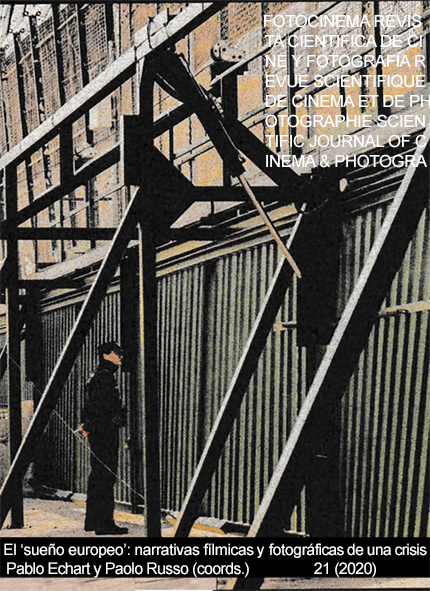Order, Truth, Beauty: The Poetics of Mac-Mahon
DOI:
https://doi.org/10.24310/Fotocinema.2020.vi21.10011Keywords:
Mac-Mahon, Michel Mourlet, Cahiers du cinéma, Présence du cinéma, Modern CinemaAbstract
In the early sixties, the cinephiles of the Mac-Mahon aproached the journal Cahiers du cinéma: during a short period of time, they were protected by Éric Rohmer and their influence on the journal grew quickly. The macmahonians advocated for a transparent mise en scène, a cult of certain virile actors, an eulogy of violence and, in general, a categorical, intolerant and dogmatic tone of writing, with a strongly belligerent attitude. Their perspective created a discontent among some of the established critics of Cahiers du cinéma and the group ended up moving to the journal Présence du cinéma that, since then, became the propagandist organ of the macmahonian doctrine. This article studies the implications of this absolutist poetics (defined by Daney as a “right wing bazinism”) which tried to rehabilitate Aristotelian assumptions in the precise moment when modern cinema was more inclined to put into practice Brecht ideas.
Downloads
Metrics
References
Aumont, J. (2010). El cine y la puesta en escena. Buenos Aires: Colihue.
Cerisuelo, M. (2013). Le Mac-Mahon : histoire et legende. En Creton, L. y Kitsopanidou, K. (Eds.), Les salles de cinéma. Enjeux, défies et perspectives (pp. 19-28). París: Armand Colin.
Collet, J., Delahaye, M, Fieschi, J., Labarthe, A. y Tavernier, B. (1962). Entrevista con Jean-Luc Godard. En VV.AA., La Nouvelle Vague: sus protagonistas (pp. 95-130). Barcelona: Paidós.
Curtelin, J. (1961). Avant-propos. Présence du cinéma nº 9, 1-2.
de Baecque, A. (1991). Histoire d’une revue (Tome I : À l’assault du cinéma 1951-1959). París: Cahiers du cinéma.
Daney, S. (1983). La rampe. París: Cahiers du cinéma.
Douchet, J. y Moullet, L. (1962). Cannes 1962. Cahiers du cinéma nº 132, 22-35.
Hillier, J. (1986). Cahiers du cinéma 1960-1968: New Wave, New Cinema, Reevaluating Hollywood. Cambridge: Harvard University Press.
Hoveyda, F. (1960a). La réponse de Nicholas Ray. Cahiers du cinéma nº 107, 13-24.
Hoveyda, F. (1960b). Les taches du soleil. Cahiers du cinéma nº 110, 33-43.
Kané, P. (1978). Réponse a «CNC». Cahiers du cinéma nº 293, 52-55.
Lourcelles, J. (1967). Avant propos. Présence du cinéma nº 24/25, 1-2.
Marcorelles, L. (1963). Interview: Roger Leenhardt with Jacques Rivette. Sight and Sound, 4 (32), 168-173.
Moullet, L, (1959). Sam Fuller sur les brisées de Marlowe. Cahiers du cinéma nº 93, 11-23.
Mourlet, M. (1959). Sur un art ignoré. Cahiers du cinéma nº 98, 23-38.
Mourlet, M. (1960a). Apologie de la violence. Cahiers du cinema nº 107, 24-28.
Mourlet, M. (1960b). Beauté de la connaissance. Cahiers du cinema nº 111, 34-38.
Mourlet, M. (1961). Du côté de Racine. Présence du cinéma nº 9, 29-32.
Mourlet, M. (1965). Cinéma, poésie et autres. Sur un art ignoré (pp. 93-94). París: La table ronde.
Présence du cinéma. (1963). Éditorial. Présence du cinéma nº 18, 1-2.
Roud, R. (1960). The French Line. Sight and Sound 4 (29), 166-171.
Serguine, J. (1960). Éducation du spectateur ou l’École du Mac-Mahon. Cahiers du cinéma nº 111, 39-45.
Skorecki, L. (1978). Contre la nouvelle cinéphilie. Cahiers du cinéma nº 293, 31-51.
Downloads
Published
How to Cite
Issue
Section
License
All contents published in Fotocinema Revista científica de cine y fotografía are protected under the Creative Commons Attribution-NonCommercial-ShareAlike 4.0 International (CC BY-NC-SA 4.0) license. All about this license is available in the following link: <http://creativecommons.org/licenses/by-nc-sa/4.0>
Users can copy, use, redistribute, share and exhibit publicly as long as:
- The original source and authorship of the material are cited (Journal, Publisher and URL of the work).
- It is not used for comercial purposes.
- The existence of the license and its especifications are mentioned.
There are two sets of authors’ rights: moral and property rights. Moral rights are perpetual prerogatives, unrenounceable, not-transferable, unalienable, imprescriptible and inembargable. According to authors’ rights legislation, Fotocinema. Revista científica de cine y fotografía recognizes and respects authors moral rights, as well as the ownership of property rights, which will be transferred to University of Malaga in open access. The property rights are referred to the benefits that are gained by the use or the dissemination of works. Fotocinema. Revista científica de cine y fotografía is published in an open access form and it is exclusively licenced by any means for doing or authorising distribution, dissemination, reproduction, , adaptation, translation or arrangement of works.
Authors are responsable for obtaining the necessary permission to use copyrighted images.













13.png)




